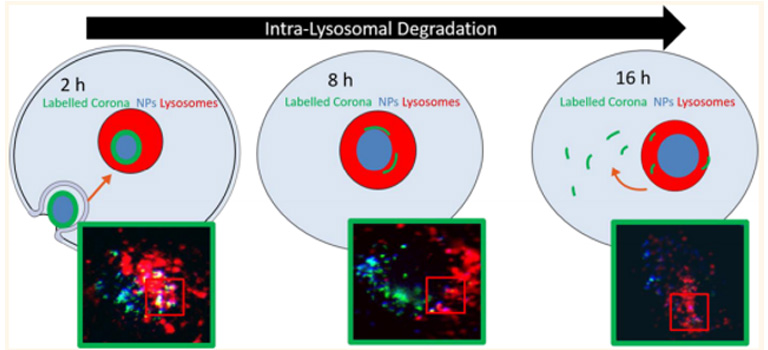How do nanoparticles influence the biological environment they are in contact with? What happens once nanoparticles enter the cells?
To develop novel ways of using nanoparticles in diagnostics and therapeutics, it is crucial to obtain a detailed understanding of the mechanisms of how nanoparticles interact with and influence cells. In combination with controlled nanoparticle design, this knowledge serves to eliminate questions of efficacy and safety in nano-diagnostics and therapeutics and to advance current technologies in the arena.
To determine the fate of cells shortly after nanoparticle uptake, we perform high-content analysis (HCA) in conjunction with real-time multicolour imaging. This method addresses questions of nanoparticle toxicity and degradation on a population level. HCA allows for objective, quantitative and simultaneous analysis of morphological parameters such as number, shape, staining intensity and texture of cellular and sub-cellular structures - as well as the variance in these parameters across the cell population.
On a cellular level, we apply proteomics approaches to identify the nanoparticle-induced changes in protein synthesis and the signalling pathways that are disrupted by the cellular uptake and accumulation of nanoparticles.

Nanoparticle−cell interactions are governed by protein corona adsorbed by the nanoparticle surface from the surrounding biological environment. Subsequent to initial contact with the cell membrane, nanoparticles are typically internalized into the cell and trafficked along defined pathways such as the endolysosomal pathway. Here, using a combination of techniques for organelle separation and fluorescence imaging, we show that some proteins present in the original protein corona are retained on the nanoparticles until they accumulate in lysosomes, and, once in the lysosomes, they are degraded.(Bertoli et al., ACS Nano, 2016)
Selected Publications:
Bertoli, Filippo, et al. "The intracellular destiny of the protein corona: a study on its cellular internalization and evolution." ACS Nano 10.11 (2016)
Anguissola, Sergio, et al. "High content analysis provides mechanistic insights on the pathways of toxicity induced by amine-modified polystyrene nanoparticles." PloS one 9.9 (2014)
CBNI grouping investigating BioNano Interactions
School of Chemistry and School of Biomolecular and Biomedical Science, University College Dublin (UCD), Belfield, Dublin 4, D04 N2E5, Ireland. T: +353 1 716 2293 | E: info@cbni.eu | Location Map(opens in a new window)Monday - Friday | 09.00-17.30 Ireland and UK | 10.30-18.30 CET | 00.30-08.30 PST | 17.00-01.30 Japan | 01.00-09.30 PDT